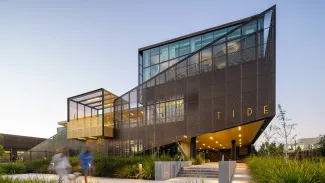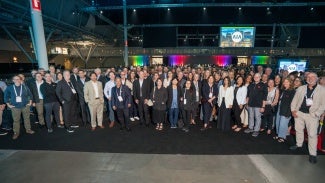
When progress stalled, LPA doubled down on performance
After posting disappointing 2023 results in the AIA 2030 Commitment, LPA president Keith Hempel, FAIA, explains the firm's efforts to do better.
Our firm uses the AIA 2030 Commitment as the key metric for measuring our progress toward designing carbon neutral buildings. Last year, when we reported our results for 2023, we were in for a shock.
After reducing predicted energy use by 78.7% across more than 6.2 million square feet of projects in 2022, our best-ever result, the overall performance of our projects had fallen to an average of 71.4%, a 7% decline.
For us, the 2023 result was a step backwards. The drop, after years of a steady upward trajectory, prompted serious self-reflection about our process and rigor. Like many firms, we had reached a point where we appeared to be plateauing, and we needed to push forward and find a way to get to that next level.
We knew our projects were still performing far above the industry average of a 50% pEUI reduction, and the results were partially attributable to challenging project types and an increase in the number of renovations. But we had to face the possibility that we had taken our foot off the gas pedal. We’d seen years of steady improvement and maybe we simply thought that the momentum was going to naturally continue. That didn’t happen.
The 2023 numbers were a wakeup call. As a team, we’ve made the AIA 2030 Commitment one of the key measures of our performance. Looking at the decline, we committed to taking a hard look at what we needed to improve and fine tune.
What we changed
As a result of those discussions, we made specific changes that increased our rigor for the 2024 reporting cycle.
We asked teams to conduct monthly reviews of their project's predicted performance. The monthly check-ins gave us the opportunity to model earlier in the process to inform design as opposed to waiting until the end of the year to compile data for the AIA 2030 Commitment Report.
Our Sustainability and Applied Research team, led by Ellen Mitchell, used the check-ins as an opportunity to discuss the modeling results with the architects, designers and engineers, as a team. Hard questions were asked. If there were still unknowns, the process allowed the team to explore options and consider news ideas.
We developed targets for each project and held ourselves accountable. We worked to have conversations earlier in the project, making sure every discipline was involved in the discussions that developed baselines and targets aligned with the client’s goals.
In the process, we returned to our roots and the core elements that drive our process: everything counts, there is always a way, and we don't do this alone. Rather that pointing fingers, we focused on sharing information.
- We celebrated wins in our all-hands meetings. We also ramped up the performance focus in our LPA-U education sessions and increased the number of “elevate” sessions, where different practices come together to evaluate on-the-board projects.

The result
In 2024 we posted a 76.2% predicted energy use reduction in our projects, the second-highest result in our history. It’s still not where we want to be, but in a rapidly changing political and economic landscape, we were able to work with our clients and get better.
The improvement in our results validated our renewed focus. It made a difference and served as a reminder that we can change the trajectory of our work. The data illustrates that we made progress in several areas, even though we still have work to do.
On the positive side, we reported a record number of projects — 131, including 75 interior projects — covering 4.3 million square feet. Of the total, 28 projects surpassed the 80% target. We saw progress in five of our six studios from a year earlier, including a 15% improvement in our San Antonio studio. In 2023 we had 18 projects that did not hit a 60% pEUI; this year it was only five, illustrating that we are doing a good job of raising the performance floor for our projects.
On the flipside, we can see where we need to improve. The number of projects including renewable energy has essentially flatlined in recent years. We’re only going to get so far with passive design strategies and increasing building efficiency. To hit the 90% reduction target, which goes into effect this year, we need to make the case with our clients for the benefits of renewable energy.
At this point, we understand what the path to net zero energy looks like. We’ve learned and evolved our design process. And we know we need buy-in from our clients to make it happen. As an integrated design firm, we have a unique opportunity to lead research-based discussions and illustrate the long-term payback in reducing carbon emissions in projects.
These conversations are not getting easier. There’s a lot of uncertainty in the marketplace. In the face of new challenges, we must be more prepared and more informed than ever to help our clients make good decisions.
Keith Hempel, FAIA, is president of LPA Design Studios, which won AIA's 2025 Architecture Firm Award.
